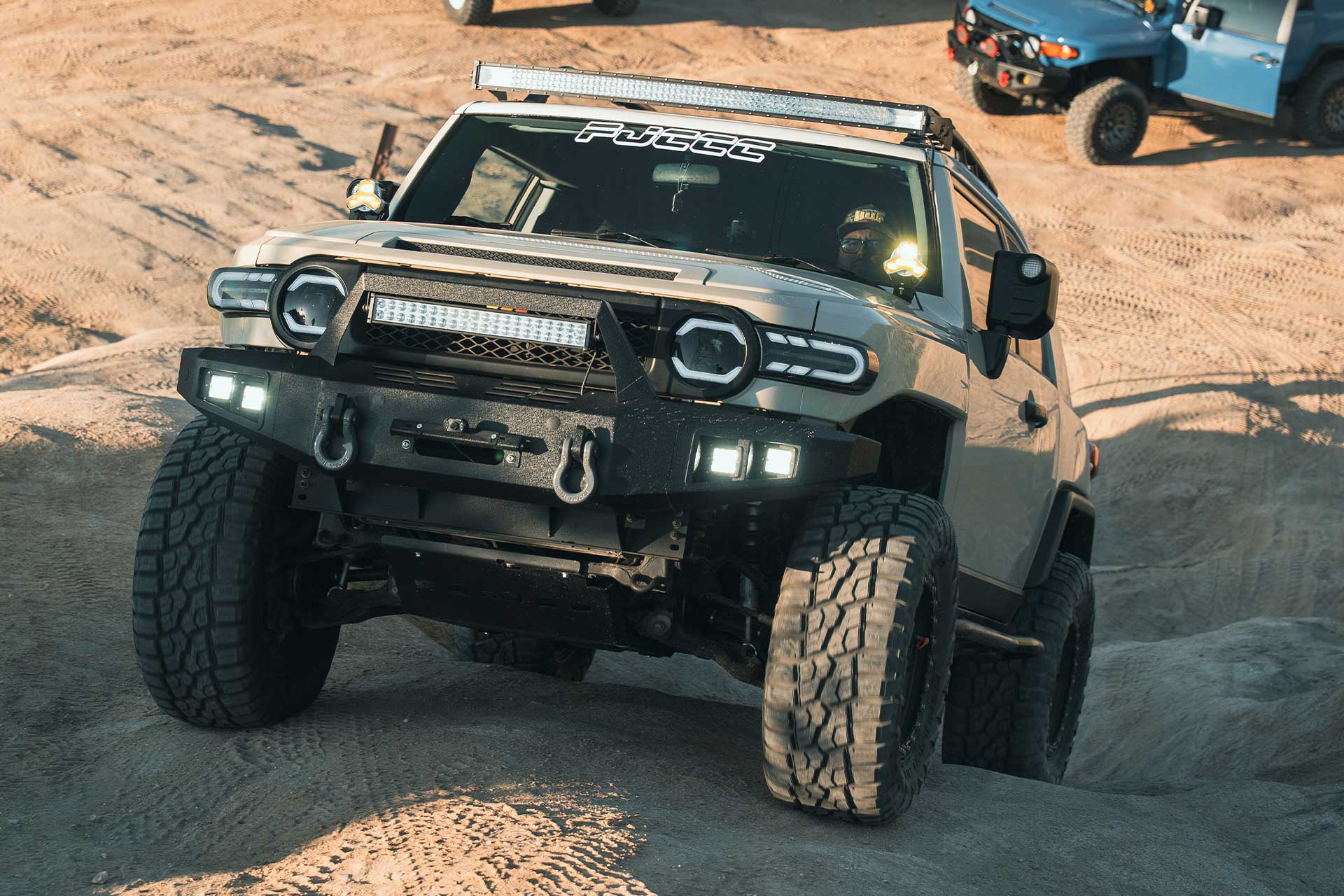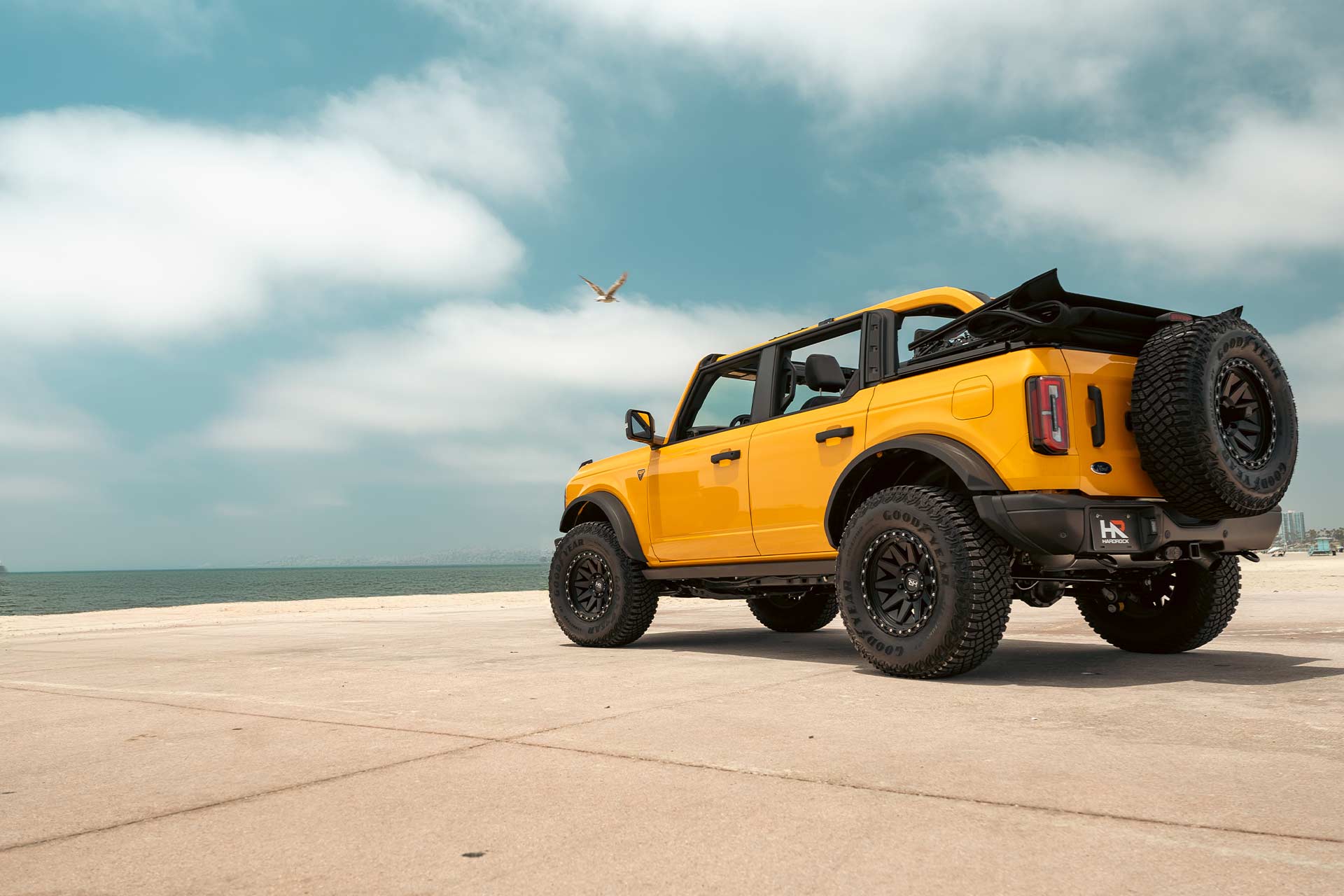How Tire Size Affects Wheel Requirements
You just mounted those aggressive 35” BFG K02s you’ve been dreaming about, only to realize your wheels are completely wrong for the setup. The offset pushes your tires into the fenders, the width has bead seating issues, and the load ratings can’t handle the increased weight. Now what?
Here’s the unfortunate reality that a lot of us have to learn the hard way: going up in tire size isn’t just about finding wheels that bolt on. The relationship between tire size and wheel specs (diameter, width offset, and backspacing) determines whether your build actually performs on the trails or not.
In this guide, we’ll cut through the confusion surrounding off-road wheel requirements for tire upgrades. We won’t be diving too deep on how to choose a tire size, but rather to make sure that once you’ve found the perfect set of off-road tires, you choose wheels that maximize the performance, safety and reliability of your rig. Because at Hardrock Offroad, we’ve seen too many builds compromised by wheel choices that looked right but performed wrong.
The Tire-Wheel Relationship
Wheel Diameter
Moving to bigger tires, the right wheel diameter becomes a critical performance decision. There’s a strong correlation between tire size and wheel size that directly affects your sidewall height, and this impacts nearly every aspect of your off-roading experience.
Big tires are typically paired with smaller wheel diameters to maximize sidewall height. That larger sidewall is your cushion and traction surface, protecting against punctures and damage. A 35″ tire on a 17″ wheel gives you 9 inches of sidewall to work with, while the same tire on a 20″ wheel leaves you with only 7.5 inches.
So with that in mind, it’s important to understand that there are immediate performance trade-offs when using bigger wheels in off-road situations. Smaller wheels with taller sidewalls offer superior ride quality and increased traction surface area for technical trails and terrain. That doesn’t mean wheels over 17″ aren’t viable, as they have their own benefits. It comes down to how you use your rig.
For serious off-road applications, you should prioritize sidewall height over wheel size. Trust us, your suspension and drivetrain will thank you.
Load Capacity
Here’s one that gets overlooked way too often: ignoring load capacity when upgrading tire sizes. Bigger tires mean more weight, and more weight calls for wheels engineered to handle the increased load safely.
Those sick 37″ mud-terrains you’ve been eyeing might weigh 30-40 pounds more per corner than your stock setup, and that extra weight transfers directly to your wheel. Factor in the added stress of off-road driving, and you quickly understand why proper load ratings aren’t optional.
The bottom line is that mismatched load capacities are non-negotiable. Wheel failure due to insufficient load rating can result in complete loss of vehicle control, or even serious injury. This isn’t about following manufacturer recommendations—it’s about taking real-world off-road stresses into account.
For a more in-depth look on calculating proper load requirements for your specific setup, check out our comprehensive off-road wheel load capacity guide that breaks down the mathematics and safety considerations.

Wheel Specs for Tire Size Changes
Offset and Backspacing
When you increase the width of your tire, offset and backspacing requirements change dramatically. Wider tires push outward from your vehicle’s centerline, and your wheel specifications must accommodate this change while maintaining proper suspension geometry and avoiding interference issues.
Tire width increases generally require wheels with less backspacing (more negative offset) to maintain clearance from suspension components, brake lines, and steering mechanisms. However, this isn’t a simple calculation. Vehicle-specific considerations including suspension travel, steering angle limitations, and fender clearances all factor into the equation.
The key here is understanding that offset changes affect more than just clearance. Offset changes your rigs track width, which can impact stability, handling and stress distribution throughout your drivetrain. Get it wrong, and you’ll experience everything from premature bearing wear to erratic handling characteristics that can compromise safety in challenging terrain.
Wheel Width
In addition to offset, it’s critical to take tire-to-wheel ratios seriously: the wider the tire, the wider the wheel.
For most off-road applications, the width of the tire should fall within specific ratios relative to wheel width. If the wheel is too narrow, you could have bead seating problems and compromise sidewall support. Too wide a wheel stretches the tire profile, reducing sidewall flexibility and increasing vulnerability to sidewall damage.
This becomes even more important when you consider air pressure variations, which is common in off-road driving. Airing down for sand or rock crawling puts more stress on the tire-wheel interface, and incorrect width ratios can lead to bead unseating.

Calculating Wheel Load Ratings
Moving to 33" Tires
The most popular tire upgrade is going from stock to 33’s. This size provides a significant improvement in capability without the complexity of more extreme sizing. For 33″ tires, it’s common to see wheels from 15″ up to 17″.
Offset requirements depend entirely on the width of the tire, but most setups benefit from 0 to -12mm offset to accommodate the size increase. In terms of wheel width, these setups typically run 8″ to 9″, providing sufficient bead support without compromising sidewall flex.
The beauty of 33’s is that they’re mostly compatible with stock truck suspension geometries. It’s not unheard of to see stock vehicles accommodating 33″ tires with little to no suspension modifications.
Upgrading to 35" Tires
Back in the day, moving to a 35″ tire meant you’re a serious trail junkie. However, with the size of modern rigs, the popularity of 2″+ suspension lifts, and the general rise in popularity of off-roading, mounting a 35 isn’t as scary as it used to be.
The most optimal choice for a tire this size is a 17″ off-road wheel. This setup still gives you the sidewall flex and brake clearance you need to tackle trails. Offset wise, the choices are similar to the 33″ setup: 0, -12mm and -19mm. This depends entirely on the platform however, and in more aggressive setups, requires fender modifications to avoid rubbing during articulation.
Width requirements generally range from 8.5″ to 10″, depending on specific tire design and intended use. For example, rock crawling applications often favor a narrower wheel, while pre-running applications may benefit from wider wheels for improved stability.
Going to 37"+ Tires
Entering 37″+ territory means you’re building a serious machine, and your wheel requirements reflect this commitment to extreme performance. These tire sizes demand wheels engineered specifically for heavy-duty applications, with load ratings that significantly exceed standard passenger vehicle specifications.
Wheel diameter selection for 37″+ tires typically centers around 17″ options, maximizing sidewall height for protection and traction surface area. However, brake clearance becomes increasingly critical, and some vehicles may require 18″ wheels to accommodate larger brake systems.
Here’s where it gets sort of confusing. The offset requirements don’t change all that much from 33″ to 37″+. Still, most enthusiasts running 37’s or more opt for a -12mm or -19mm offset. But it’s important to understand that running a setup like this may require extensive modifications including fender cutting and suspension adjustments. In the end, it all depends on how you use your vehicle and how often you’re actually off-roading.
Before considering beadlock wheels for these applications, understand that most off-road scenarios don’t actually require beadlocks despite the hype surrounding them. Our detailed analysis in The Truth About Beadlock Wheels explains when beadlocks provide genuine benefits versus when they’re simply overkill.
Finding the Right Wheels
To choose the right off-road truck wheels for your build, you need to follow a systematic approach. Start with load capacity calculations for specific tire choice and size. Next, verify offset and backspacing requirements using actual suspension travel measurements if possible. Measure clearances with maximum suspension compressed and full steering lock to identify potential bottlenecks. Finally, confirm wheel width specs that align with your tires specs for proper bead seating and sidewall support.
Professional fitment consultation can prevent mistakes and ensure your wheel selection is optimized for performance. At Hardrock Offroad, our fitment specialists understand the complexities of wheel-tire relationships and can provide guidance for your specific vehicle platform and use-case.
Build it Right, Build it Once
Upgrading your tires represent a significant investment in your build’s capability, and proper wheel selection ensures that investment delivers the performance you’re looking for. It’s easy to overlook these things when going for an off-road wheel and tire fitment, but it’s vital to ensure the safety of you, your rig and those around you on the trails.
Understanding these relationships will allow you to make a smarter decision. Whether you’re moving up to 33″ tires for weekend trail running or building a prerunner with 37’s, choosing the right wheels forms the foundation of a successful build.
Here at Hardrock Offroad, we’re not just selling 4×4 wheels—we’re helping fellow off-road enthusiasts build machines that perform when it matters the most. Because when you’re miles from civilization facing challenging terrain, having the right equipment isn’t just about convenience; it’s about getting home safely with stories worth telling.
Ready to build it right? Contact our fitment specialists for personalized wheel selection guidance that matches your tire upgrade with wheels engineered for your specific application and performance requirements.
FAQs
How do I calculate the correct wheel specifications when upgrading from 33" to 35" tires?
Here's the deal: jumping from 33s to 35s means recalculating everything. Those 35s typically weigh 10-15 pounds more per corner, so check our wheel load capacity guide first. Offset-wise, you'll generally move from 0 to -12mm (typical for 33s) to around -12mm to -25mm for 35s. Wheel width should bump up from 8-9" to 8.5-10". Don't guess on this stuff; contact our fitment specialists for the exact specs based on your rig and tire choice.
Can I use my existing wheels if I'm only increasing tire width, not diameter?
Not always. Going wider affects more than just wheel width, it changes your offset needs and load distribution too. That wider tire pushes outward, potentially requiring different backspacing to keep everything clear of your suspension components. Plus, wider tires usually weigh more, which might exceed your current wheels' load ratings. Better to verify compatibility than find out the hard way on the trail.
Why do you recommend smaller wheel diameters for serious off-road use when larger wheels look better?
Because we prioritize performance over looks, and bigger sidewalls deliver better off-road capability. A 35" tire on a 17" wheel gives you 9" of sidewall—that's your cushion and rock protection. Same tire on a 20" wheel? Only 7.5" of sidewall. Those missing inches are the difference between floating over rocks and smashing into them. Trust us, your suspension will thank you for maximizing sidewall height.
What's the most dangerous mistake people make when selecting wheels for tire upgrades?
Ignoring load capacity. We see this way too often—people focus on fitment and looks while completely overlooking whether their wheels can handle the weight and stress of bigger tires. Wheel failure from inadequate load rating can mean losing control completely. This isn't about following recommendations; it's about real-world safety when you're miles from nowhere.
Do I really need different wheel specifications for rock crawling versus desert running?
Absolutely. Rock crawling benefits from narrower wheels that let your sidewalls bulge for maximum traction and protection. Desert running needs wider wheels for sidewall support during high-speed cornering and heat dissipation. These aren't minor differences—they determine whether your setup excels in your terrain or becomes a compromise that sucks everywhere.
How do I know if I need professional fitment consultation versus figuring it out myself?
If you're asking this question, you probably need our help. Wheel-tire relationships involve load ratings, offset calculations, and clearance requirements that go way beyond basic compatibility. Our fitment guys have seen every combination of rig, tire, and use case. The consultation cost is nothing compared to buying wrong wheels twice or dealing with problems on remote trails.



